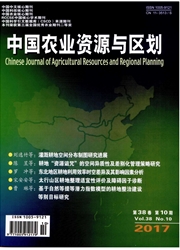

 中文摘要:
中文摘要:
该文模拟了未来2030年气候变化和社会经济情景下东北地区粮食作物玉米、水稻和大豆空间竞争情况,并将竞争结果空间化,以期为相关研究和农业区域布局政策制定提供参考。该文设置A2C1D1(IPCCA2 CO2排放气候变化情景、农民无打工收益、3种作物政府收购价格翻一番)、A2C1D2(IPCCA2 CO2排放气候变化情景、农民无打工收益、3种作物政府价格翻二番)、B2C2D1(IPCC B2 CO2排放气候变化情景、农民无打工收益、3种作物政府收购价格翻一番)和B2C2D2(IPCC B2 CO2排放气候变化情景、农民无打工收益、3种作物政府价格翻二番)等4种IPCC气体排放气候变化和社会经济混合情景,与2009年3种作物空间竞争结果比较,可以得到如下结论:1)在A2C1D1情景下,玉米面积所占粮食作物农田面积比例由82.3%下降到77.36%,大豆由7.7%上涨至8.93%,水稻则由10%上涨到13.71%,空间上,玉米在小兴安岭与嫩江平原区之间的过渡地带及辽宁省腹地水系较为发达地区的周边地区有所减少,而大豆在小兴安岭与嫩江平原区之间的过渡地带,水稻在辽宁省腹地辽河平原面积相应有所增加;2)在A2C1D2情景下,玉米面积比例由82.3%下降到75.56%,而大豆由7.7%上涨至9.52%,水稻则由10%上涨至14.92%,空间上,这一情景的变化与A2C1D1非常相似;3)在B2C2D1情景下,玉米所占面积比例由82.3%上升到84.16%,而大豆由7.7%下降至7.27%,水稻由10%则下降到8.57%,空间上,玉米面积在小兴安岭与嫩江平原区之间的过渡地带和辽宁水系较为丰富的腹地地区,大豆种植区在小兴安岭与嫩江平原区之间的过渡地出现萎缩,而水稻在辽宁腹地种植面积逐渐减少,这一现象与A2C1D1和A2C1D2相反;4)在B2收购价格翻两番的情景下,玉米所占面积比例由82.3%下降到80.06%,而大豆由7.7%上升至9.01%,而水稻由10%则上涨到10.93%,空间上分布没有明显变化。从指导实际生产的角
 英文摘要:
英文摘要:
In this paper, the Northeast China including the 3 provinces of Heilongjiang, Liaoning and Jilin was regarded as study area where maize, rice and soybean were main food crops. Simulation of spatial competition of the 3 crops under 4 future combined scenarios of IPCC CO2 emission and socio-economic development(urbanization rate and governmental purchasing price for food crops) was conducted for the year of 2030 by application of the FCS(farmer crop selection) model() and EPIC(environmental policy integrated climate) model. The 4 final scenarios were A2C1D1, A2C1D2, B2C2D1 and B2C2D2. A2C1D1 represented a combination scenario by IPCC A2 option, farmers having no income when going to city to do temporary work and prices for food crop purchased by government doubling. A2C1D2 meant a combination scenario by IPCC A2 option, farmers having no income when going to city to do temporary work and prices for food crop purchased by government quadrupling. B2C2D1 was a combination scenario by IPCC B2 option, farmers having income when going to city to do temporary work and prices for food crop purchased by government doubling. B2C2D2 denoted a combination scenario by IPCC B2 option, farmers having income when going to city to do temporary work and prices for food crop purchased by government quadrupling. In comparison with simulation results in 2009, the conclusions were: 1) For the first scenario of A2C1D1, percentage of maize acreage to total arable land decreased to 77.36% from 82.3%, and meanwhile there was an increase from 7.7% and 10% to 8.93% and 13.71% for soybean and paddy rice, respectively; spatially, maize acreage declined in the fringe areas between the Lesser Xing'an Mountain and the Haerbin Plain, but in the Liaohe Plain acreages of soybean and rice went up respectively. 2) For the second scenario of A2C1D2, percentage of maize acreage to total arable land decreased to 75.56% and meanwhile that of soybean and paddy rice increased to 9.52% and 14.92%, respectively; spatially the change was
 同期刊论文项目
同期刊论文项目
 同项目期刊论文
同项目期刊论文
 Using an Integrated Response-Function Method to Explore Agro-Climatic Suitability for Spring Soybean
Using an Integrated Response-Function Method to Explore Agro-Climatic Suitability for Spring Soybean Proposing an interdisciplinary and cross-scale framework for global change and food security researc
Proposing an interdisciplinary and cross-scale framework for global change and food security researc Global-scale modelling of potential changes in terrestrial nitrogen cycle from a growing nitrogen de
Global-scale modelling of potential changes in terrestrial nitrogen cycle from a growing nitrogen de Simulated impact of elevated CO2, temperature and precipitation on winter wheat yield in North China
Simulated impact of elevated CO2, temperature and precipitation on winter wheat yield in North China Study on the feasibility and reasonability of the calculation methods of consolidating rural residen
Study on the feasibility and reasonability of the calculation methods of consolidating rural residen 期刊信息
期刊信息
